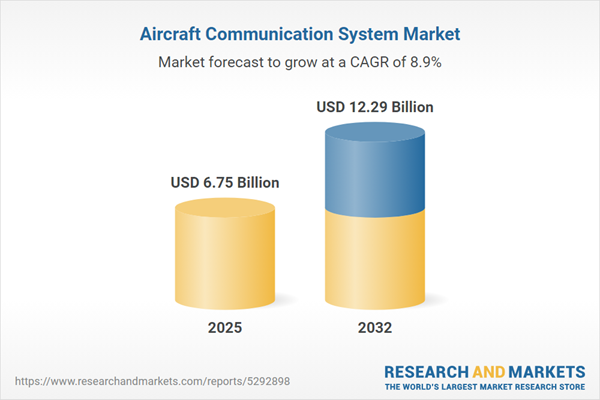Speak directly to the analyst to clarify any post sales queries you may have.
The aircraft communication system market is evolving rapidly, driven by greater connectivity demands and digital transformation across the aviation sector. Senior leaders must navigate this landscape to ensure their fleets remain compliant, resilient, and prepared for regulatory developments, emerging threats, and shifting passenger expectations.
Market Snapshot: Aircraft Communication System Market Size and Growth
The aircraft communication system market reached USD 6.19 billion in 2024, with projections indicating expansion to USD 6.75 billion by 2025. The sector is forecast to grow at a compound annual growth rate (CAGR) of 8.93% through 2032, when it is expected to achieve a value of USD 12.29 billion. Growth is propelled by rising demand for satellite connectivity, advanced digital solutions, and evolving operational requirements. Enhanced avionics elevate crew performance, advance safety standards, and establish reliable in-flight and ground communications as foundational capabilities for modern fleets. The sector’s leading players are concentrating on interoperable and standardized solutions, addressing the need for seamless connectivity across commercial and defense aircraft.
Scope & Segmentation: Strategic Overview of the Aircraft Communication System Market
This market is defined by a multi-layered segmentation framework designed to guide technology selection and compliance management for diverse fleet needs. Key segments include:
- Component: Antennas, audio management units, communication management units, radio tuning units, receivers, software-defined radios, transceivers, transmitters, and transponders each play a unique role in maintaining secure data flow for both cockpit and cabin operations.
- Communication Technology: High frequency (HF), very high frequency (VHF), satellite communications (SATCOM), along with Ka-Band, Ku-Band, and L-Band address varying reliability and coverage requirements, supporting uninterrupted crew and passenger communications on any mission profile.
- Platform: Solutions are tailored for business jets, commercial airlines, and military aircraft, enabling compliance with sector-specific certification standards and accommodating a wide variety of operational models.
- Fit: Both line fit and retrofit integration options are available, supporting new aircraft deployment and enhancement of legacy fleets to meet updated regulatory or business requirements.
- Connectivity: Data link systems, HF, VHF, SATCOM, UHF, and L-Band provide multi-tiered redundancy, improving operational resilience and addressing critical safety concerns under diverse operational conditions.
- Application: Air traffic control communications, crew collaboration, mission management, and broadband in-flight services are central applications, each directly impacting flight safety, mission efficiency, and passenger experience.
- Regional Coverage: The Americas, Europe, Middle East & Africa, and Asia-Pacific adopt communication technologies at varied rates, shaped by infrastructure readiness and region-specific regulatory frameworks.
- Leading Companies: Major industry players steering technical advancement and driving sector standards include Honeywell International Inc., Collins Aerospace Inc., Thales Group, Viasat, L3Harris Technologies, Inmarsat plc, Iridium Communications, Gogo Inc., Cobham Limited, and Garmin Ltd.
Key Takeaways for Decision-Makers
- Integrated connectivity platforms streamline compliance and transparency in complex aviation environments, supporting both safety and operational objectives.
- Adaptive communication networks reduce exposure to service interruptions, ensuring higher fleet reliability and stronger business continuity strategies.
- Modular and scalable system architectures simplify integration, enabling operators to respond quickly to evolving fleet requirements and accelerating future technology upgrades.
- Regional market trends reveal differing approaches: Asia-Pacific often prioritizes scalable, cost-conscious deployments, whereas other regions focus on infrastructure modernization to extend fleet lifespan and address diverse mission profiles.
- Collaboration among technology providers, airframe manufacturers, and regulatory authorities underpins robust supply chain management and supports compliance, especially for organizations with multinational or mixed-model fleets.
- Strategic investment in segment- and region-specific standards helps reinforce resilience and competitive positioning as the market adapts to new regulatory and operational challenges.
Tariff Impact on Global Supply Chains
Upcoming U.S. tariffs in 2025 are prompting suppliers to diversify sourcing and production, increasing presence in Asia-Pacific and broadening their supplier networks. Companies are adopting modular system design and flexible leasing to adjust rapidly to trade changes, strengthen supply chain continuity, and maintain uninterrupted fleet operations for both commercial airlines and defense customers.
Methodology & Data Sources
This analysis draws on comprehensive secondary research from recognized industry sources and regulatory bodies, supplemented by direct input from aviation sector leaders. The methodology ensures that recommendations are objective and actionable for market participants navigating evolving regulatory and technological trends.
Why This Report Matters
- Delivers a timely and structured assessment of the aircraft communication system market, facilitating effective strategy formation amid changing regulations and supply chain complexities.
- Empowers executive teams to make confident decisions on technology adoption, partner engagement, and compliance planning within fast-moving aviation markets.
- Equips organizations to anticipate technological and regional shifts, enhancing their resilience and ensuring alignment with long-term business goals.
Conclusion
The ongoing evolution of aircraft communication systems is setting new benchmarks for connectivity, compliance, and operational efficiency. Strategic insights presented here support executive decision-making on investments and technology alignment across global aviation fleets.
Additional Product Information:
- Purchase of this report includes 1 year online access with quarterly updates.
- This report can be updated on request. Please contact our Customer Experience team using the Ask a Question widget on our website.
Table of Contents
3. Executive Summary
4. Market Overview
7. Cumulative Impact of Artificial Intelligence 2025
Companies Mentioned
The companies profiled in this Aircraft Communication System market report include:- Honeywell International Inc.
- Collins Aerospace Inc. by Raytheon Technologies Corporation
- Thales Group
- Viasat, Inc.
- L3Harris Technologies, Inc.
- Inmarsat plc
- Iridium Communications Inc.
- Gogo Inc.
- Cobham Limited
- Garmin Ltd.
Table Information
| Report Attribute | Details |
|---|---|
| No. of Pages | 196 |
| Published | October 2025 |
| Forecast Period | 2025 - 2032 |
| Estimated Market Value ( USD | $ 6.75 Billion |
| Forecasted Market Value ( USD | $ 12.29 Billion |
| Compound Annual Growth Rate | 8.9% |
| Regions Covered | Global |
| No. of Companies Mentioned | 11 |









